| |
| FM 52 from
the Prussian Seebataillon
Photos © Vincent Koch |
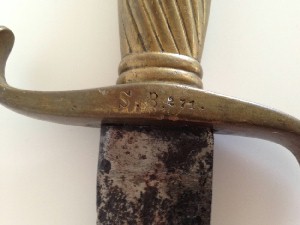 |
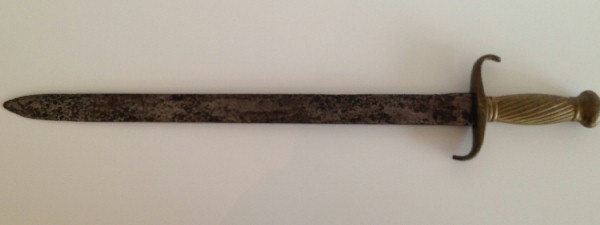 |
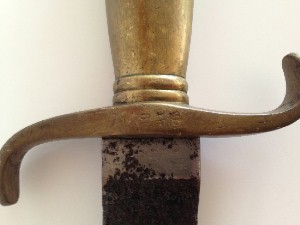 |
|
The markings "S.B.271" show this
1852 Faschinenmesser to have been issued to the Prussian
Seebataillon, weapon number 271. Prior to the formation of the
II. Seebataillon in 1889 no battalion numbers were needed to be
marked. The makers mark cannot be read on the aged blade. It is
date marked "FW60" on the reverse side of the hilt for King
Frederick William IV of Prussia 1860. |
| |
|
|
| FM 52
from the II. Seebataillon
Photos © Chris Wood |
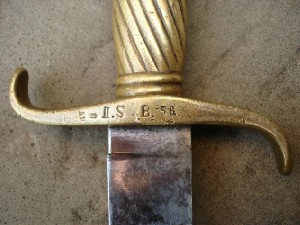 |
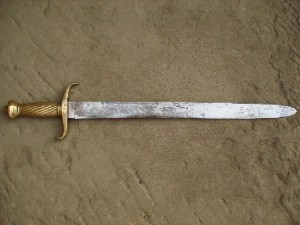 |
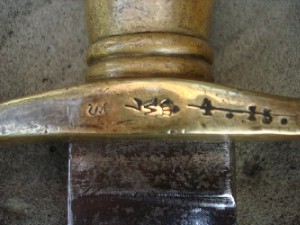 |
| The markings
"II.S.B.56" on this Prussian 1852 Faschinenmesser show it to
have been issued to the II. Seebataillon, weapon number 56. On the
other side is a Prussian crown and W (for Wilhelm I) and "7_" with
the last digit of the date missing and cancelled markings for
previous issue "4.15". |
Füs S60
Bayonet from the Prussian Seebataillon
Photos © Roy Williams, the author of
The Collectors Book of German Bayonets |
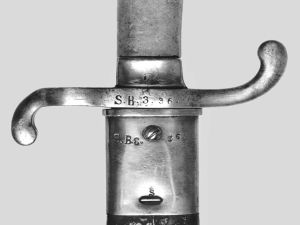 |
| |
The markings "S.B.3.36."
on the hilt and scabbard show this Füsilier-Seitengewehr 1860 bayonet to have been issued to the
3rd company of the Prussian Seebataillon, weapon number 36.
The company number 3, is accidentally stamped upside down on the scabbard. Prior to the formation of the II.
Seebataillon in 1889 no
battalion numbers were needed to be marked. It was made by F
Hörster of Solingen. It is date marked "FW61" for
King Frederick William IV 1861. The curious point here is that
Frederick William IV died on 2nd January 1861, so it seems likely
that bayonets were still being marked with his monogram
posthumously. This bayonet has a
brass grip (not very clear in this monochrome photograph)
and a leather scabbard.
|
|
|
|
|
S98aA Bayonet from the III.
Seebataillon
Photos © Chris Wood |
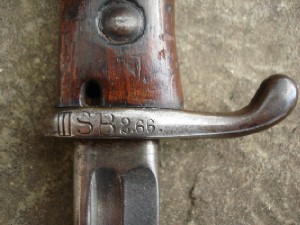 |
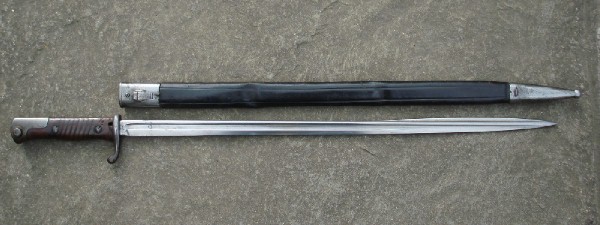 |
|
The markings "III.SB. 2.66."
show this bayonet to have been issued to the III. Seebataillon based
at Tsingtao, 2nd
company, weapon number 66. It was made at Erfurt and is date stamped "W00" for 1900.
Like all S98aA
bayonets, it has a wooden grip and a leather scabbard. Note the fold
marks on the scabbard. This tendency to damage when the bayonet was
unsheathed was one of the reasons that that led to later bayonets
such as the kS98 having steel scabbards.
S98aAS Bayonet from the III. Seebataillon
Photos © Dow Cross |
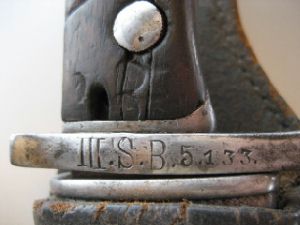 |
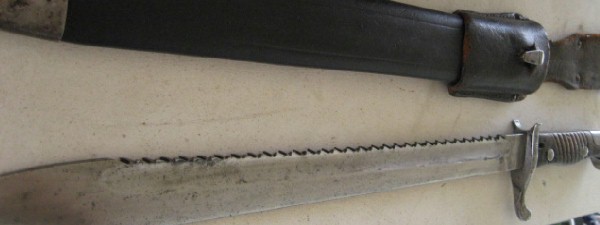 |
|
The markings
"III SB 5.133" show this bayonet to have been issued to the 5th
(Mounted) Company of the III. Seebataillon based in Tsingtao, weapon number 133. Being
mounted infantry rather than cavalry, the 5th Company carried bayonets
rather than swords. This
bayonet has a sawback blade, a wooden grip and a leather scabbard.
This bayonet was made at Erfurt in 1910 (marked "W10").
S98aA Bayonet from the
East Asian Marine Detachment
Photos © Chris Wood |
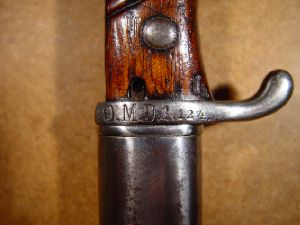 |
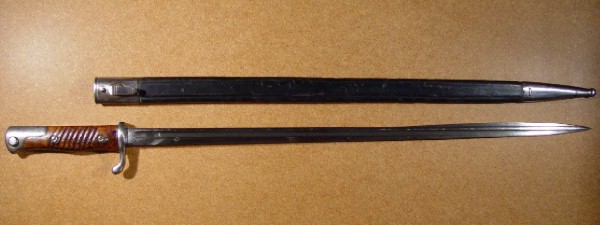 |
|
The markings "O.M.D.1 124" show this
bayonet to have been issued to the 1st Company of the East Asian
Marine Detachment ("Ostasiatische Marine Detachment")
based at Peking and Tientsin, weapon number 124. This bayonet was made
by Simson & Co in Suhl and has no date marking though it was probably
made around 1900-01. The one piece wooden grip on this S98aA was
discarded in favour of the two piece grips of the S98nA in 1902. As
the bayonet has no signs of previous issue markings it may well have
been kept in storage
for sometime before being issued: the East Asian Marine Detachment
was only formed in 1909. This bayonet has a leather
scabbard.
S98aA Bayonet from the I. Seebataillon
Photos © Joe Fishpaw |
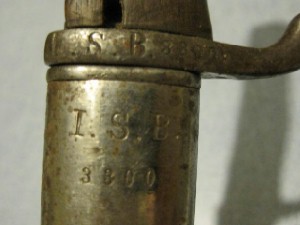 |
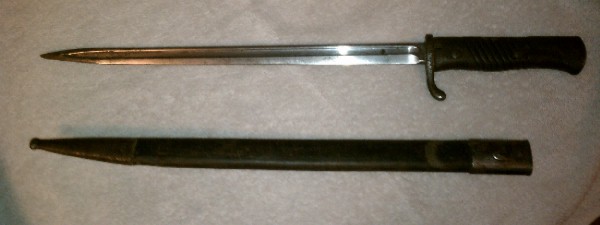 |
|
The markings "1.S.B.3300" on the hilt and
scabbard, show this bayonet to have been issued to the I.
Seebataillon, weapon number 3300. As is typical for I. Seebataillon
bayonets it has no company number. This bayonet was made by Simson &
Co in Suhl and has no date marking. This is a shortened bayonet with
the leather scabbard shortened to match. Period photographs further
confirm the use of shortened S98 bayonets by the imperial navy.
Privately Made
S98nA Bayonet from the I. Seebataillon
Photos © Chris Wood |
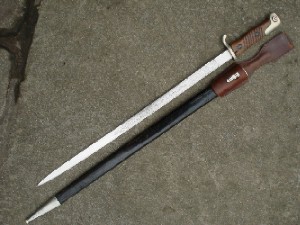 |
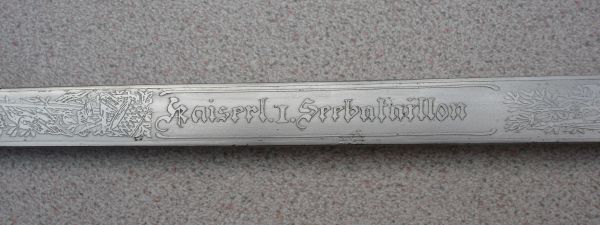 |
|
This bayonet has no standard unit, date or
manufacturer's markings. Like many
officers and NCOs edged weapons it is privately made for dress
purposes, this one does not actually fit a rifle. It has a flat
blade with a decorative engraving reading "Kaiserl. I.
Seebataillon" (with "Kaiserliche"
or imperial abbreviated). Other privately made naval bayonets and
swords had even more elaborate blade engravings, often showing
ships, anchors and other nautical themes, sometimes with
blue and gold panels. It has wooden grips and a leather scabbard. More S98 Bayonets from the Marine Infantry |
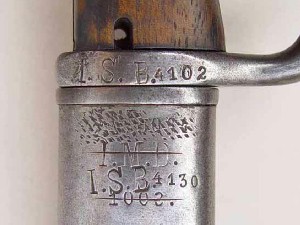 |
| |
This
S98aA bayonet has the
markings "I.S.B. 4102" on the hilt showing it to have been issued to the
I. Seebataillon based at Kiel, weapon number 4102. The
scabbard is marked "I.S.B.4130" showing it originally to
have been issued with bayonet number 4130. Non-matching
bayonet and scabbard combinations are quite common and while
some may have been put together by post-war collectors many
may also have been in use by the Marine Infantry when one or
other was damaged or lost. The scabbard also has cancelled
markings "I.M.D. 1003" from a previous issue to the I.
Matrosen Division of the Imperial navy. Another set of
cancelled markings above it cannot be clearly read.
The bayonet was made at Erfurt in 1900 (marked "W00").
Photo ©
Roy Williams |
|
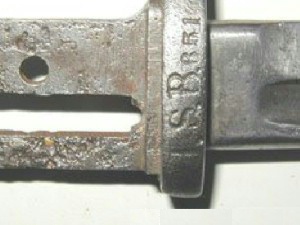 |
| |
This
S98aA bayonet has the
markings "I.S.B. 651" on the hilt showing it to have been issued to the
I. Seebataillon, weapon number 651. It was made by Simson &
Co in Suhl and has no date marking. As can be seen, it is
missing its wooden grip. The one piece wooden grip on the
old style ("alter Art") S98 bayonets was prone to
splitting as may have happened here.
Photo © Shawn
Gibson of
Bayonet
Connection |
|
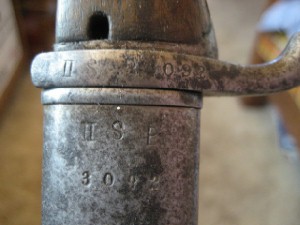 |
| |
This S98aA bayonet has the markings "II.S.B.
3092" on the hilt and scabbard showing it to have been issued to the
II. Seebataillon based at Wilhelmshaven, weapon number 3092.
It was made by Simson & Co in Suhl and has no date marking.
Photo © Dow Cross
|
|
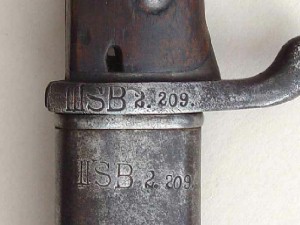 |
| |
This
S98nA bayonet has the
markings "III.S.B.2.209."
on the hilt and scabbard showing it to have been issued to the
III. Seebataillon, 2nd company, weapon number 209. It was made
Simson & Co of Suhl in 1906 (marked "M06", the "M"
standing for Marine). The new style ("neuer Art") of
S98 bayonet had two piece wooden grips, which solved the
problem of the one piece grips used on S98 "alter Art"
bayonets splitting.
Photo ©
Roy Williams |
|
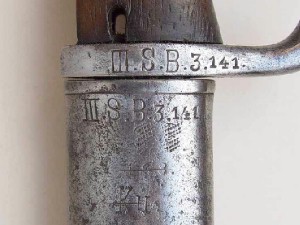 |
| |
This S98aA bayonet has the markings "III.S.B.3.141."
on the hilt and scabbard, showing it to have been issued to
the III. Seebataillon, 3rd Company, weapon number 141. It
was made by Simson &
Co of Suhl and has no date marking. It has previous
cancelled markings "183" above "Ku" on the scabbard. These
"Ku" markings have been noted on other III.
Seebataillon
bayonets and may possibly have been for "Gouvernment
Kiaotschou" personnel such as the Tsingtao Polizeitruppe.
Photo ©
Roy Williams
|
|
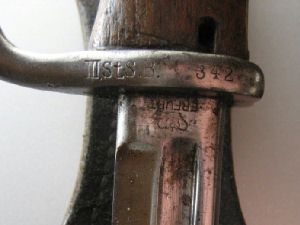 |
| |
This S98aA bayonet has the markings "III. St SB. 342" showing
to have been issued to the depot unit ("Stamm") of
the III. Seebataillon based at Cuxhaven in Germany, weapon number 342.
This bayonet was made at Erfurt (the factory's mark can be seen in the
photograph) in 1900 (marked "W00").
Photo © Dow Cross |
|
|
|
|
|
S98/05aAS Bayonet from the III. Seebataillon Photos
© Chris Wood |
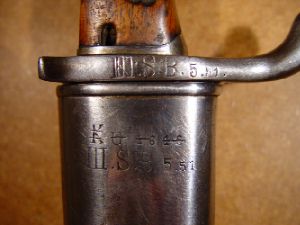 |
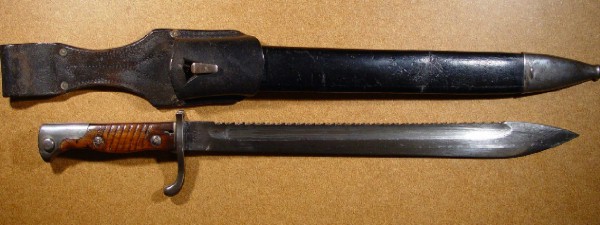 |
|
The markings "III.SB. 5.51." on
the hilt and scabbard show
this bayonet to have been issued to the 5th (Mounted) Company of the
III. Seebataillon, weapon number 51. This bayonet also has the cancelled markings "Ku 1616" from a
previous issue. No known German unit has been identified with the Ku
marking although it has been suggested that it might represent the
German Government in Kiaochow ("Gouvernment Kiautschou") and was therefore
issued to troops of the Naval Authorities such as the Tsingtao Chinese
Polizeitruppe. This bayonet was made at Erfurt in 1909
(marked "W09"). It has wooden grips, a sawback blade and a leather
scabbard. The frog is of an older pattern originally for a larger
bayonet and has been altered to fit this bayonet.
|
|
|
|
S98/05aA Bayonet from the II.
Seebataillon Photos
© Chris Wood |
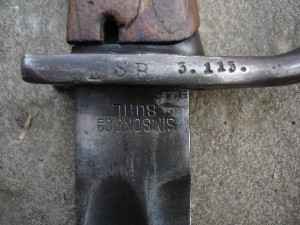 |
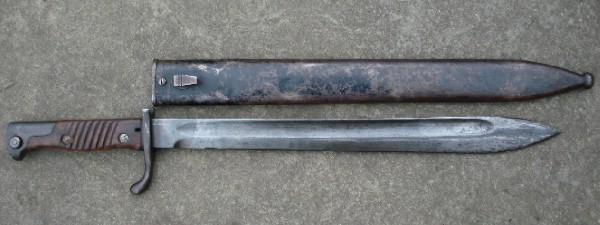 |
|
The markings "II SB 3.113." show this
bayonet to have been issued to the 3rd Company of the II.
Seebataillon, weapon number 113. As can clearly be seen from the
markings on the blade, this bayonet was made by Simson & Co in Suhl
and has no date
markings. The
bayonet can however be dated somewhere between 1906, when the S98/05
was introduced and 1915 when the new variant S98/05nA came into
production. It has wooden grips, which may have been re-fitted from
another bayonet as they appear ill-fitting and a steel scabbard. |
|
|
|
|
|
S98/05aA Bayonet from the II.
Seebataillon Photos
© Chris Wood |
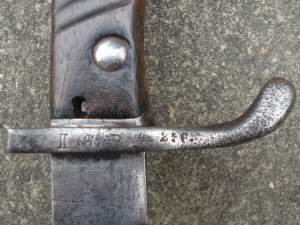 |
| |
|
| |
The markings "II.S.B.4.236" show
this bayonet to have been issued to the 4th Company of the II.
Seebataillon, weapon number 236. It has wooden grips, an
unmarked steel scabbard and was
made at Erfurt in 1914, marked W14. |
|
|
|
|
|
|
S98/05aA Bayonet from the II.
Seebataillon Photos © Shawn
Gibson of
Bayonet
Connection |
 |
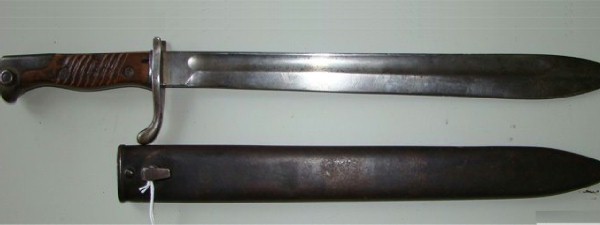 |
|
The markings "II SB" show this bayonet to
have been issued to the II. Seebataillon. This bayonet has neither
company nor quite unusually a weapon number. This bayonet was made
by Simson & Co in Suhl (as can clearly be seen from the markings on
the blade in the left photograph) and has no date marking. It has
wooden grips and a steel scabbard. |
|
|
|
S98/05nAS Bayonet from the I. Seebataillon
Photo © Chris Wood |
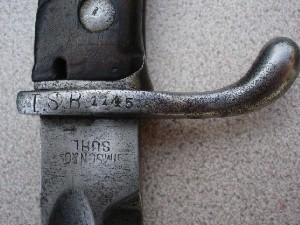 |
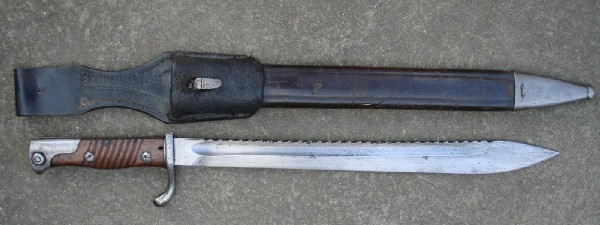 |
|
The markings "I. S.B. 1145" show this bayonet to have been issued to the I.
Seebataillon,
weapon number 1145. The manufacturer's
mark (which can clearly be seen in the photograph on the left) is for Simson & Co
of Suhl. It is date marked "W15" for 1915 by which time the I.
Seebataillon had been expanded into the 1. Marine-Infanterie
Regiment of the Marinekorps Flandern on the Western Front. This bayonet is a curious transitional version of the S98/05
with the low muzzle ears of the S98/05nA whilst not having a flashguard like the S98/05aA.
It has a sawback blade, wooden grips and a leather scabbard. |
|
|
|
|
kS98 Bayonet from the East Asian Marine
Detachment
Photo © Chris Clemons |
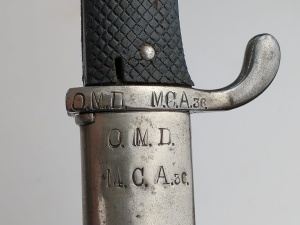 |
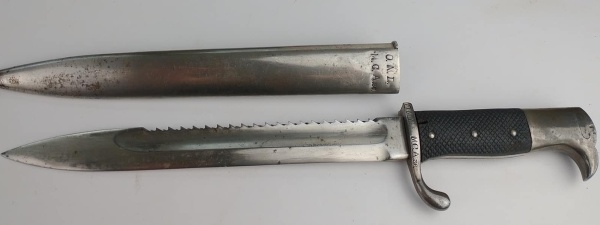 |
|
The markings "O.M.D. M.C.A.
36" show
this bayonet to have been issued to the East Asian Marine
Detachment ("Ostasiatische Marine Detachment"). As the
kS98 bayonet was issued to machine gunners in the Marine
Infantry, it seems reasonable to assume that "M.C.A." represents
the Maschinengewehr-Abteilung, with a C
replacing a missing letter G perhaps. It has the weapon number 36. It has
a sawback blade (common to all kS98), chequered leather grips, a
matching marked steel scabbard and was
made at Erfurt in 1913, marked W13. |
|
|
|